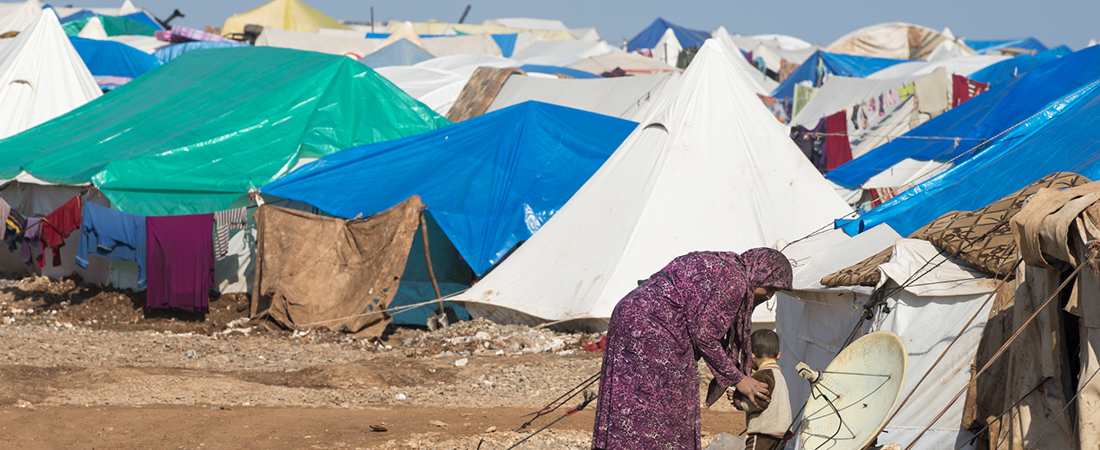The growing intensity and complexity of humanitarian disasters requires us to work in innovative ways. Stephen O'Brien, the United Nations' Under-Secretary General for Humanitarian Affairs and Emergency Relief Coordination, outlines why. Originally published on Portland.
Today, a record 135 million people across 35 countries need humanitarian aid to survive. The scale of humanitarian suffering continues to grow exponentially as complex, inter-connected conflicts last for years without resolution, and protracted natural disasters, compounded by climate change, throw vulnerable people into a state of perpetual crisis.
This year a complex combination of human-made and environmental factors has put a staggering 20 million people in four countries alone – Nigeria, Somalia, South Sudan and Yemen – at risk of famine. To provide sustainable solutions to saving lives and building resilience in these countries and globally, the international community needs to shift its approach by putting vulnerability reduction at the centre of our collaboration.
This requires us to adopt a new way of working, in which humanitarian and development actors, the private sector, governments, regional bodies and academia stop working in siloes to collaborate on risk and needs-reduction. We must work together to monitor potential risks and pre-plan how to reduce them to better anticipate and avert crises. This will require early action and injections of funding before crises grow so that at-risk people will be able to better cope.
In the current famine crisis, for instance, this would mean donors unleash financing now, based on risk indicators of further failed rains. Humanitarian agencies will deliver emergency food aid and support to herders, and at the same time, development actors will invest in health infrastructure, agriculture and water and sanitation to shore up resilience. In line with this new way of working, clearly articulating the collective outcomes to reduce needs, risk and vulnerability that we want to achieve together in affected countries over the next three to five years must be part of our response planning.
A number of tools are emerging to support these resilience-building models, from national safety-net programmes to solutions such as risk insurance and catastrophe bonds.
Take risk insurance as an example. By helping vulnerable people, as well as at-risk states and institutions, to access insurance, we can collectively close the protection gap so that people and institutions protect their assets in the face of shock. Pay-outs will occur when rains do not arrive, or floods are on their way. These risk management tools can deliver value for money for donors and save costs for emergency responders.
Data from the climate-risk insurance mechanism, the African Risk Capacity, shows that US$1 spent on the mechanism is equal to $4 in traditional emergency assistance. More than 200 experts and practitioners from the insurance industry, Governments, NGOs and academia have formed the Insurance Development Forum, which commits to insure 400 at-risk vulnerable people across developing and middle-income countries. This is one of several ambitious initiatives attempting to reframe our approach to vulnerability.
This new way of working will also entail rethinking humanitarian finance. We must overcome the structural and financial barriers that block our collaboration. At the 2016 World Humanitarian Summit, Governments and institutions signed on to the ‘Grand Bargain’, which stresses a shift from an over-reliance on annual plans for protracted crises to multi-year strategies that engage in building resilience.
By committing to the Grand Bargain, donors and investors are showing they are ready to provide predictable and flexible financing that encompasses humanitarian and development goals. We must also do more to fund critically under-funded sectors that can overcome the humanitarian-development divide, including preparedness, livelihoods, education and early recovery. All signatories have committed to work closely with local actors to lead these changes.
The Grand Bargain also gives us the opportunity to scale up the use of cash-based programming and contribute to better coordination in its delivery. The large-scale use of cash-transfer programming in response to Typhoon Haiyan in the Philippines and throughout the Syria crisis added substantially to the increasing body of evidence showing that it can be a highly efficient, effective and accountable means of meeting the needs of people affected by crises.
There is also an increasing understanding of the potential role of cash in linking humanitarian and development action. For instance, emergency cash assistance can build on existing social protection systems. In Ethiopia and Pakistan, the Governments called on OCHA to help them link emergency cash to their existing social safety-net schemes.
Momentum is building around the new way of working. The UN Secretary-General fully recognizes that resilience is the hallmark of the UN’s 2030 Agenda, in which Member States committed to ‘leave no one behind’, including people at risk of crises. To deliver on this, he plans to reposition development to be at the forefront of the UN’s work. The World Bank and other financial institutions are already moving to increase their financing in fragile contexts. Development and humanitarian actors, including the Government of Denmark, OCHA, UNDP and the World Bank, are creating political momentum around this new approach to ensure that all get on board.
In this time of great uncertainty and mounting risk for peace and sustainable development, these commitments are a testament to our collective recognition that we must do more and do it together to deliver an enduring legacy of sustainable development for the 135 million most vulnerable people around the world.
Source: portland-communications.com

